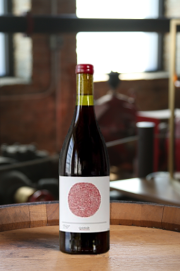- Analysis
- Vineyards
- Vinification and Aging
- Tasting Notes
- 2014 Vintage Notes
Tim Martin 2014 Qaisar
Wine of Origin
Swartland
Varietals
100% Mouvedre
Analysis
Wine Maker: Tim Martin
Alcohol: 12.5%
pH: 3.63
Total Acidity: 5.2 g/l
Residual Sugar: 1.9 g/l
Total Production: 183 cases
I want to learn more about vineyards and improve the quality of my grapes. I work organically (no chemical entrants other than sulphur and copper) with some biodynamic (preparation 500) and permaculture (straw mulching) influences. A primary goal here has been to increase the biodiversity in the vineyard, both above and below ground.
The grapes I buy from another vineyard (Qaisar) are organically farmed. I plan to gradually add more vineyards sources which are farmed organically until I reach the point where all wines are made from organically farmed grapes.
In the meantime I try to source from as many high quality organic vineyards as I can but don’t turn down grapes from conventionally farmed vineyards if they are of high quality and the farmer is open to moving to more sustainable practices.
I believe strongly that vineyards are the most important determinant of wine quality and character. The final wine can only aspire to do justice to the raw material.
The wines are all made and bottled at the winery in Salt River, Cape Town using traditional methods. For white wines I use a basket press and the must is fermented in large format oak vessels (500l to 2000l), after which it goes through malolactic fermentation and is aged on its lees with no batonnage. Red wines are fermented in wooden open top vessels (“cuves tronconique”) before they are basket pressed and aged in neutral barrels or or preferably larger oak vessels (foudres). During the ageing / élevage process I like to keep the wines slightly reductive and to maintain some dissolved carbon dioxide. I believe this keeps the wines fresher and less vulnerable to oxidation.
I like to work with whole bunches, both when pressing white grapes and fermenting red grapes. No additions to grapes or wine are made aside from sulphur and tartaric acid (when judged to be unavoidable). This means no yeasts, no enzymes, no tannins, no oak chips, no mega purple, no bacteria, no egg whites etc.
Each wine is from a specific vineyard rather than being a blend of wines from different vineyards. I love the idea of having, in my glass, a hyperlapse in liquid form of everything that happened in a very specific place between one harvest and the next. Every ray of sun, gust of wind and drop of rain that happened in that small place is represented in that glass of wine. Also, I really like Burgundy and that’s kind of how they do it there.
100% Mourvèdre from an 18 year old, organic, dry farmed, cordon trained vineyard north of Malmesbury, Swartland. Deep, red, iron rich, clay based soils. Grapes are hand harvested and 100% whole bunches are fermented in a French oak open top wooden fermenter. Light extraction with limited pigeage/ foulage (punch downs) and almost no pump overs. Pressed after 21 days. Aged in a mix of neutral 228l and 500l french barrels for 11 months. Spontaneous malolactic fermentation and ageing on primary lees before racking to tank for bottling with a light non sterile sheet filtration.
The 2014 Qaisar by Tim Martin is an elegant take on a notoriously rugged varietal – Mouvedre. Bright red raspberry and black cherry are supported by hints of eucalyptus, allspice, and clove. Secondary notes of tea rose and cracked pepper lead you into the intense mineral core that you rarely find in “new world” wines.
An exceptional year, with much higher yields – especially in dryland areas – and the promise of very high quality wines.
Initial vineyard growth was slow due to late cold fronts in August, followed by cool, wet weather at the beginning of the growing season. This led to a high incidence of disease, and rainfall mid-November further hampered effective disease control by creating challenging spraying conditions and limiting access to vineyards. As a result, downy mildew resulted in crop losses early on in the season in some areas. The climate was favorable for flowering thereafter, and good berry set was obtained. However, after the high rainfall mid-November, vigorous growth ensued, requiring extra input to ensure high grape quality and disease prevention via good canopy aeration and sunlight exposure. Ideal dry, moderate conditions reigned during ripening in January and mid-February, after which a warm period accelerated ripening and resulted in great pressure on intakes in some areas. Cooler weather in March enhanced color formation and flavor retention in later red cultivars. Regular rainfall at the end of March delayed ripening again and extended the harvest to mid-April.

